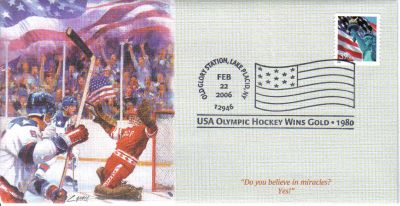1980 U. S. A. Olympic Hockey Team

In hockey the puck hard rubber
disk whose function is
comparable to a ball in
other sports draws the
attention of twelve,
well-padded players on skates.
Using angled wooden sticks
(in French a "hoquet" is
a shepherd's crook)
to catch and pass the puck,
players sprint up, down and
across a 200-foot
long rectangular
arena called a rink.
With or without the puck,
they feint, attack, brake in
a spray of ice,
and drive opponents into
barriers enclosing the rink.
Always, the primary object
is to score a goal by directing
the puck into the opponent's
basket-like net at one end of
the rink, while the purpose of a
team's goalie is to prevent that
occurrence by catching or
deflecting the puck away.
The roots of hockey are
buried deep in antiquity,
but the modern game of ice
hockey began in Canada in
the 1850s.
By the 1890s the game had
spread to the U.S. and since
1917 the National Hockey League
has been the world's premier
professional association with 28
teams vying for a championship
trophy the Stanley Cup.
The premier hockey event in
international competition takes
place during the Winter Olympic
Games which began in 1924
in Chamonix, France.
The Olympics featured amateur
competition until 1998
when professionals,
as well as women, played for
the first time in Nagano, Japan.
With the increase in the pace
of life the up-tempo game of
hockey has grown in popularity,
and today the vast majority of
hockey games are played by
kids on frozen ponds or on
urban, concrete courts
and asphalt streets.


0 Comments:
Post a Comment
<< Home